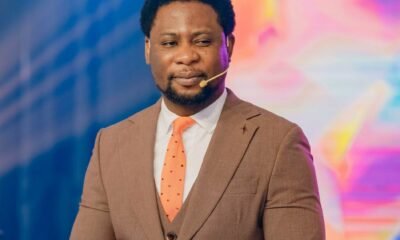News
Mass Killer Names Those That Encouraged Him To Hunt Blacks

A convicted mass killer has named those who encouraged him to hunt and kill blacks.
A South African, Louis van Schoor had been behind the shooting dead of dozens of black men during apartheid, and has now spilled the beans of those that stood behind him..
He reportedly told the British Broadcasting Corporation Africa Eye that the police sanctioned his violence. And that others were equally to blame for the killings he carried out as a security guard.
We reproduce below, a BBC report on the famed apartheid mass killer.
Van Schoor’s bed is immaculately neat – the duvet so flat it looks like it has been ironed. The air is heavy with the smell of cigarettes, their stubs piled high in an ashtray. Strips of sticky paper are dangling from the ceiling, writhing with trapped and dying flies.
The so-called “Apartheid Killer” has lost his teeth. His health is waning. Following a heart attack, both his legs were recently amputated, leaving him in a wheelchair, with painful scars. When his surgeon carried out this procedure, Van Schoor requested an epidural instead of a general anaesthetic – so he could watch them remove his legs.
“I was curious,” he said, chuckling. “I saw them cutting… they sawed through the bone.”
READ ALSO: South African Returnee Arrested For Alleged Robbery In Lagos
In speaking to the BBC World Service, Van Schoor wanted to persuade us that he is “not the monster that people say I am”. His enthusiastic description of his legs being removed did little to soften his image.
Over a three-year period in the 1980s under the country’s racist apartheid system – which imposed a strict hierarchy that privileged white South Africans – Van Schoor shot and killed at least 39 people.
All of his victims were black. The youngest was just 12 years old. The killings occurred in East London, a city in South Africa’s windswept Eastern Cape.
Van Schoor was a security guard at the time, with a contract to protect as many as 70% of white-owned businesses: restaurants, shops, factories and schools. He has long claimed that everyone he killed was a “criminal” who he caught red-handed breaking into these buildings.
READ ALSO: Easter Tragedy – 13 Killed As Church Building Collapses On Worshipers
“He was a kind of vigilante killer. He was a Dirty Harry character,” says Isa Jacobson, a South African journalist and filmmaker, who has spent 20 years investigating Van Schoor’s case.
“These were intruders who were, in a lot of cases, pretty desperate. Digging through bins, maybe stealing some food… petty criminals.”
Van Schoor’s killings – sometimes several in a single night – struck terror into the black community of East London. Stories spread through the city of a bearded man – nicknamed “whiskers” in the Xhosa language – who made people disappear at night. But his shootings were not carried out in secret.
Every killing between 1986 and 1989 was reported to the police by Van Schoor himself. But the release from prison of anti-apartheid leader Nelson Mandela in 1990 signalled an end to this impunity. Ripples of change swept across South Africa and, following pressure from activists and journalists, the security guard was arrested in 1991.
Van Schoor’s trial was one of the largest murder trials in South Africa’s history, involving dozens of witnesses and thousands of pages of forensic evidence.
READ ALSO: Save Us From Fetish Killers, Albinism Community Begs Public
However, the case against the Mass Killer largely collapsed in court. At the time of his trial, much of the apparatus of the apartheid system was still in place within the judiciary. Despite killing at least 39 people, he was only convicted of seven murders. He would go on to serve just 12 years in prison.
His other 32 killings are still classified as “justifiable homicides” by the police. Apartheid-era laws gave people the right to use lethal force against intruders if they resisted arrest or fled once caught.
Van Schoor relied heavily on this defence to maintain his innocence, claiming that his victims were running away when he killed them.



























